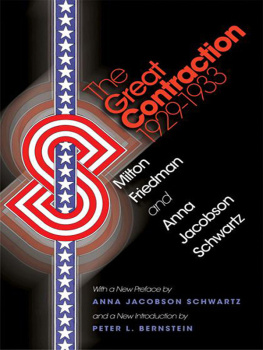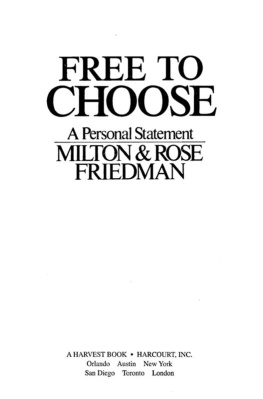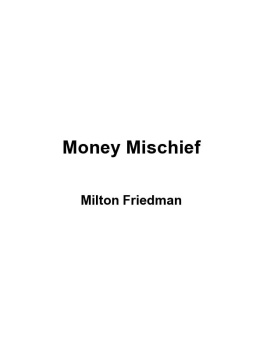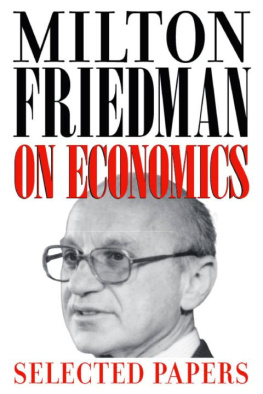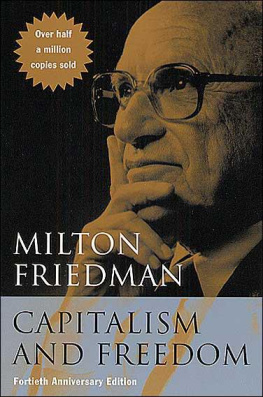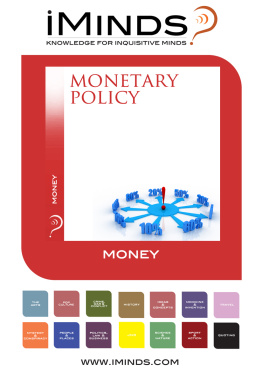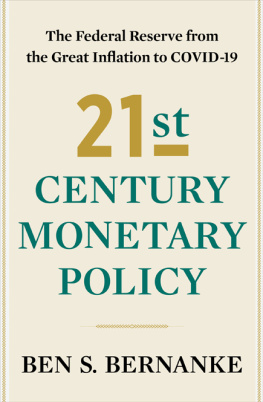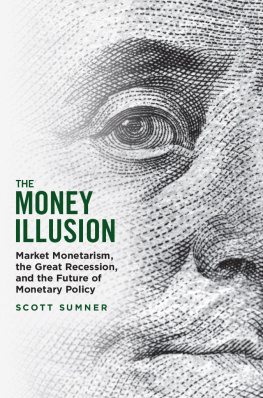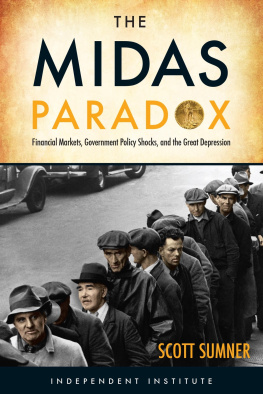
The Great Contraction
The Great Contraction 19291933
With a New Preface by Anna Jacobson Schwartz and a New Introduction by Peter L. Bernstein
MILTON FRIEDMAN AND ANNA JACOBSON SCHWARTZ
A Study by the National Bureau of Economic Research, New York
PRINCETON UNIVERSITY PRESS
PRINCETON AND OXFORD
New Preface and Introduction: The Great Contraction, Seen from the Perspective of 2007 copyright 200 by Princeton University Press
The Great Contraction, 19291933 copyright 1963, 1965 by the National Bureau of Economic Research
Requests for permission to reproduce material from this work should be sent to Permissions, Princeton University Press
Published by Princeton University Press, 41 William Street, Princeton, New Jersey 08540
In the United Kingdom: Princeton University Press, 6 Oxford Street, Woodstock, Oxfordshire OX20 1TW
ALL RIGHTS RESERVED
ISBN-13 (pbk.): 9780691137940
Library of Congress Cataloging-in-Publication Data Friedman, Milton, 19122006.
The great contraction, 19291933 / with a new preface by Anna Jacobson Schwartz and a new introduction by Peter L. Bernstein ; [by] Milton Friedman and Anna Jacobson Schwartz.
p. cm. (Princeton classic edition)
A study by the National Bureau of Economic Research.
Includes bibliographical references and indexes.
ISBN 978-0-691-13794-0 (pbk. : alk. paper) 1. MoneyUnited StatesHistory. 2. Currency questionUnited StatesHistory. 3. Monetary policyUnited StatesHistory. I. Schwartz, Anna Jacobson. II. National Bureau of Economic Research. III. Title.
HG538.F858 2009
332.4973dc22 2008007509
British Library Cataloging-in-Publication Data is available
This book has been composed in New Baskerville Typeface Printed on acid-free paper.
press.princeton.edu
Printed in the United States of America
1 3 5 7 9 10 8 6 4 2
NATIONAL BUREAU OF ECONOMIC RESEARCH FEBRUARY 27, 1980
OFFICERS
Arthur F. Burns, Honorary Chairman
James J. OLeary. Chairman
Eli Shapiro, Vice Chairman
Martin S. Feldstein, President
Charles E. McLure, Jr., Vice President
Charles A. Walworth, Treasurer
Sam Parker, Director of Finance and Administration
DIRECTORS AT LARGE
| Moses Abramovitz | Geoffrey H. Moore |
| Arthur F. Burns | Michael H. Moskow |
| George T. Conklin, Jr. | James J. OLeary |
| Morton Ehrlich | Peter G. Peterson |
| Solomon Fabricant | Robert V. Roosa |
| Martin S. Feldstein | Richard N. Rosett |
| Edward L. Ginzton | Bert Seidman |
| David L. Grove | Eli Shapiro |
| Walter W. Heller | Stephen Stamas |
| Walter E. Hoadley | Lazare Teper |
| Roy E. Moor | Donald S. Wasserman |
DIRECTORS BY UNIVERSITY APPOINTMENT
| Gardner Ackley, Michigan | James L. Pierce. California, Berkeley |
| George Leland Bach, Stanford | Lloyd G, Reynolds, Yale |
| Charles H. Berry, Princeton | Robert M. Solow, Massachusetts |
| Otto Eckstein, Harvard | Institute of Technology |
| Walter D. Fisher, Northwestern | Robert R. Sterling, Rice |
| John H. Kareken, Minnesota | Henri Theil, Chicago |
| J. C. LaForce, California, Los Angeles | William S. Vickrey, Columbia |
| Almarin Phillips, Pennsylvania | Burton A. Weisbrod, Wisconsin |
DIRECTORS BY APPOINTMENT OF OTHER ORGANIZATIONS
Eugene A. Birnbaurn, American Management Associations
Carl F. Christ, American Economic Association
Stephan F. Kaliski, Canadian Economics Association
Franklin A. Lindsay, Committee for Economic Development
Albert G. Matamoros, National Association of Business Economists
Paul W. McCracken, American Statistical Association
Douglass C. North, Economic History Association
Rudolph A. Oswald, American Federation of Labor and Congress of Industrial Organizations
G. Edward Schuh, American Agricultural Economics Association
James C. Van Horne, American Finance Association
Charles A. Walworth, American Institute of Certified Public Accountants
DIRECTORS EMERITI
| Emilio G. Collado | George B. Roberts |
| Frank Fetter | Murray Shields |
| Thomas D. Flynn | Boris Shishkin |
| Gottfried Haberler | Willard L. Thorp |
| Albert J. Hettinger, Jr. | Theodore O. Yntema |
RELATION OF THE DIRECTORS TO THE WORK AND PUBLICATIONS OF THE NATIONAL BUREAU OF ECONOMIC RESEARCH
1. The object of the National Bureau of Economic Research is to ascertain and to present to the public important economic facts and their interpretation in a scientific and impartial manner. The Board of Directors is charged with the responsibility of ensuring that the work of the National Bureau is carried on in strict conformity with this object.
2. To this end the Board of Directors shall appoint one or more Directors of Research.
3. The Director or Directors of Research shall submit to the members of the Board, or to its Executive Committee, for their formal adoption, all specific proposals concerning researches to be instituted.
4. No report shall be published until the Director or Directors of Research shall have submitted to the Board a summary drawing attention to the character of the data and their utilization in the report, the nature and treatment of the problems involved, the main conclusions, and such other information as in their opinion would serve to determine the suitability of the report for publication in accordance with the principles of the National Bureau.
5. A copy of any manuscript proposed for publication shall also be submitted to each member of the Board. For each manuscript to be so submitted a special committee shall be appointed by the President, or at his designation by the Executive Director, consisting of three Directors selected as nearly as may be one from each general division of the Board. The names of the special manuscript committee shall be stated to each Director when the summary and report described in paragraph (4) are sent to him. It shall be the duty of each member of the committee to read the manuscript. If each member of the special committee signifies his approval within thirty days, the manuscript may be published. If each member of the special committee has not signified his approval within thirty days of the transmittal of the report and manuscript, the Director of Research shall then notify each member of the Board, requesting approval or disapproval of publication, and thirty additional days shall be granted for this purpose. The manuscript shall then not be published unless at least a majority of the entire Board and a two-thirds majority of those members of the Board who shall have voted on the proposal within the time fixed for the receipt of votes on the publication proposed shall have approved.
6. No manuscript may be published, though approved by each member of the special committee, until forty-five days have elapsed from the transmittal of the summary and report. The interval is allowed for the receipt of any memorandum of dissent or reservation, together with a brief statement of his reasons, that any member may wish to express; and such memorandum of dissent or reservation shall be published with the manuscript if he so desires. Publication does not, however, imply that each member of the Board has read the manuscript, or that either members of the Board in general, or of the special committee, have passed upon its validity in every detail.
Next page
